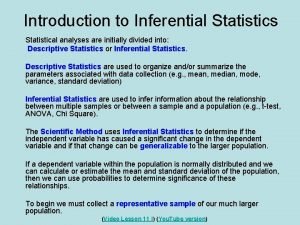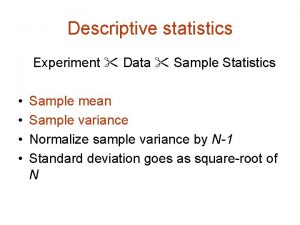Population vs Sample Population Sample population In statistics



- Slides: 3

Population vs. Sample Population Sample

population In statistics, a population is a complete set of items that share at least one property in common that is the subject of a statistical analysis. For example, the population of German people share a common geographic origin, language, literature, and genetic heritage, among other traits, that distinguish them from people of different nationalities. As another example, the Milky Way galaxy comprises a star population. In contrast, a statistical sample is a subset drawn from the population to represent the population in a statistical analysis. If a sample is chosen properly, characteristics of the entire population that the sample is drawn from can be inferred from corresponding characteristics of the sample.

Sample In statistics and quantitative research methodology, a data sample is a set of data collected and/or selected from a statistical population by a defined procedure. The elements of sample are known as sample points. Typically, the population is very large, making a census or a complete enumeration of all the values in the population impractical or impossible. The sample usually represents a subset of manageable size. Samples are collected and statistics are calculated from the samples so that one can make inferences or extrapolations from the sample to the population. This process of collecting information from a sample is referred to as sampling. The process of designing and obtaining a representative sample of a desired population requires care and can be resource intensive. The data sample may be drawn from a population without replacement, in which case it is a subset of a population; or with replacement, in which case it is a multisubset.





